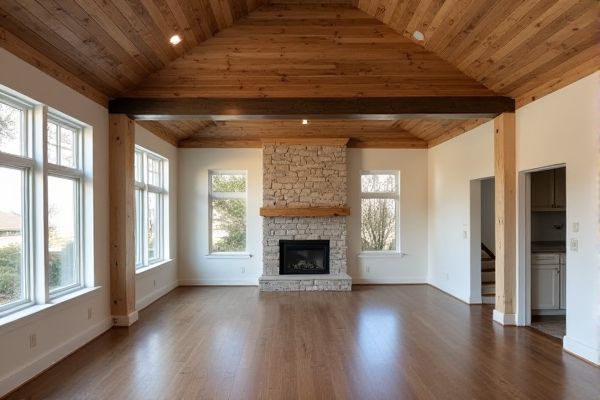
Faux wood beams offer a lightweight, cost-effective alternative to real wood beams while maintaining a similar aesthetic, making them ideal for homeowners seeking style without the heavy maintenance. Discover the key differences and benefits of each option to determine which beam best suits Your space throughout the rest of this article.
Table of Comparison
| Feature | Faux Wood Beam | Real Wood Beam |
|---|---|---|
| Material | Lightweight polyurethane or composite | Natural solid wood (oak, pine, cedar, etc.) |
| Weight | Light, easy to install | Heavy, requires structural support |
| Cost | Low to moderate | High |
| Appearance | Realistic wood grain, customizable finish | Authentic natural wood grain and texture |
| Durability | Resistant to moisture, pests, and warping | Prone to cracking, warping, and insect damage |
| Maintenance | Low; easy to clean | Requires regular sealing and upkeep |
| Installation | Simple, DIY-friendly | Complex, often requires professionals |
| Structural Support | Decorative only, no load-bearing | Load-bearing, structural integrity |
| Environmental Impact | Less sustainable, synthetic materials | Natural material, renewable if sourced responsibly |
Introduction to Faux Wood Beams vs. Real Wood Beams
Faux wood beams offer a lightweight, cost-effective alternative to real wood beams, often made from polyurethane or composite materials that mimic the appearance of natural wood without the associated maintenance issues. Real wood beams provide authentic texture, strength, and historical character valued in traditional and rustic architecture, often sourced from hardwoods or reclaimed timber. Choosing between faux and real wood beams depends on factors like budget, installation ease, durability, and desired aesthetic authenticity.
Material Composition: Faux Wood vs. Real Wood
Faux wood beams are crafted from lightweight materials such as polyurethane or MDF, engineered to mimic the appearance of real wood while offering enhanced durability and resistance to moisture, insects, and warping. Real wood beams consist of natural timber, prized for its authentic texture, grain patterns, and structural strength but require regular maintenance to prevent decay and damage from environmental factors. Choosing between faux wood and real wood beams depends on your preference for natural authenticity versus low-maintenance, cost-effective materials.
Visual Appearance and Authenticity
Faux wood beams are designed to mimic the visual appearance of real wood beams with high-quality finishes and realistic textures, often crafted from polyurethane or composite materials. Real wood beams offer unmatched authenticity through natural wood grain, unique knots, and variations in color that develop over time. While faux beams provide consistent aesthetics with low maintenance, real wood beams deliver genuine warmth and character that enhance architectural authenticity.
Weight and Structural Considerations
Faux wood beams are significantly lighter than real wood beams, reducing the load on supporting structures and making them easier to install without specialized equipment. Real wood beams offer superior structural strength and are often required for load-bearing applications where weight capacity is critical. Choosing between faux and real wood beams depends on project requirements for weight management and structural integrity.
Installation Process and Complexity
Faux wood beams offer a significantly easier installation process due to their lightweight materials like polyurethane, enabling quick mounting with basic tools and minimal structural support. Real wood beams require specialized skills for cutting, handling heavy weight, and ensuring structural integrity, often necessitating professional carpentry and reinforcement. The complexity of installing real wood beams increases with factors such as wood species, beam size, and moisture content, impacting both cost and labor time.
Cost Comparison: Faux Wood vs. Real Wood
Faux wood beams typically cost between $10 to $30 per linear foot, offering a budget-friendly alternative to real wood beams, which can range from $25 to $100 or more per linear foot depending on the wood species and size. Faux beams require less maintenance and are easier to install, reducing overall labor costs, whereas real wood beams may incur higher expenses due to finishing, sealing, and potential future upkeep. Choosing faux wood beams can significantly lower your project costs without sacrificing the aesthetic appeal of natural wood.
Maintenance and Longevity
Faux wood beams require minimal maintenance as they resist warping, cracking, and insect damage, making them ideal for humid or pest-prone environments. Real wood beams, while offering natural beauty, demand regular sealing, staining, or painting to prevent deterioration and extend their lifespan. Over time, faux beams typically outlast real wood in durability due to their engineered materials and resistance to environmental factors.
Environmental Impact and Sustainability
Faux wood beams offer a lower environmental impact by utilizing recycled materials and reducing deforestation compared to real wood beams, which require the harvesting of mature trees and contribute to habitat loss. Real wood beams provide natural carbon sequestration, storing carbon throughout their lifecycle, but their sustainability depends heavily on responsible forestry practices and certification programs like FSC (Forest Stewardship Council). Selecting faux wood beams made from eco-friendly composites can enhance durability and reduce waste, supporting sustainable building goals without compromising aesthetic appeal.
Ideal Applications and Design Flexibility
Faux wood beams are ideal for applications requiring lightweight, easy installation, and moisture resistance, making them perfect for basements, kitchens, and commercial spaces where real wood may warp or deteriorate. Real wood beams provide unmatched structural support and natural aesthetics, suitable for load-bearing applications and traditional or rustic design styles. Faux beams offer greater design flexibility with customizable sizes, shapes, and finishes, while real wood beams require specific wood species and treatments to achieve desired looks and longevity.
Making the Right Choice: Key Takeaways
Faux wood beams offer a lightweight, cost-effective, and low-maintenance alternative to real wood beams, which provide authentic grain patterns and structural strength. Consider your budget, desired aesthetic, and installation requirements when deciding between these options. Your choice impacts both the visual appeal and durability of your space, ensuring you achieve the perfect blend of style and function.
 homyna.com
homyna.com